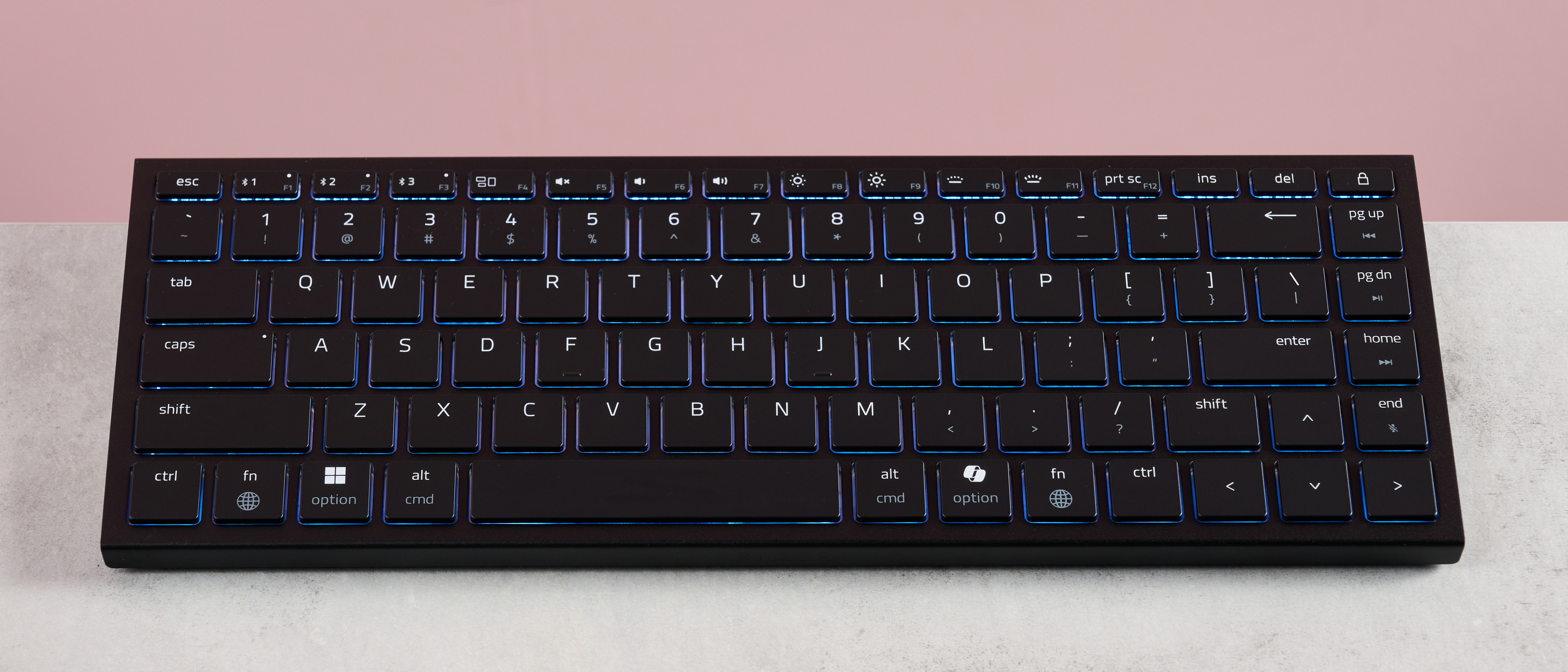TechRadar Verdict
The Razer Joro is a small gaming keyboard that fulfills its brief of being an easy peripheral to travel with. It’s also made to Razer’s exacting standards, featuring premium materials that look and feel great. However, its performance isn’t anything spectacular, and the lack of 2.4GHz might well put off more serious gamers. Combined with its lack of physical adjustability and steep price, the Joro falls short compared to better value alternatives.
Pros
- +
Small and light
- +
Well-made
- +
Useful customizations
Cons
- -
No 2.4GHz option
- -
Layout quite cramped
- -
Lacks satisfying feel
Why you can trust TechRadar
Razer Joro: one-minute review
The Razer Joro is a wireless gaming keyboard designed for easy portability thanks to its small form factor and light weight. Its looks are understated, with the all-black finish helping it to remain inconspicuous – although the RGB lighting is vibrant enough to make it stand out a little more.
It’s also built to a high standard that's typical of many peripherals made by Razer. The aluminum face plate is perhaps the highlight on this front, while its smooth planes lend a sense of elegance and class.
True to its portable nature, the Joro is very light and small across all of its dimensions. It’s slightly raised at the back, which naturally tilts the keys but only by a small degree. What’s more, this angle is set in stone, since there are no adjustable feet, meaning it might not suit everyone’s ergonomic preferences.
Razer Synapse can be used to customize the Joro, with the usual settings and features available for tweaking that you'd expect from the best gaming keyboards. There are plenty of remapping options, and there’s also a Snap Tap feature for those with more serious performance concerns.
However, the performance of the Joro itself is something of a let down. The keys don’t feel particularly great, as they are slow to rebound, as well as lacking dampening and feedback. The layout can also feel a little cramped when typing, although I was glad of the large keys.
The Joro can only connect wirelessly via Bluetooth; there’s no 2.4GHz dongle here, which is a shame. However, connections are easy to establish and switch between, helped by the practical shortcut keys for hot-switching.
The battery life isn’t particularly impressive, especially for a keyboard designed for portability. After a few days it dipped to 4%, although this was with the backlighting on constantly, which Razer does state will drain the battery much faster.
Sign up for breaking news, reviews, opinion, top tech deals, and more.
The Joro would be expensive even for a full-size board, but for a compact one with merely adequate performance and lacking multiple wireless connections, it's ultimately overpriced compared to the competition.
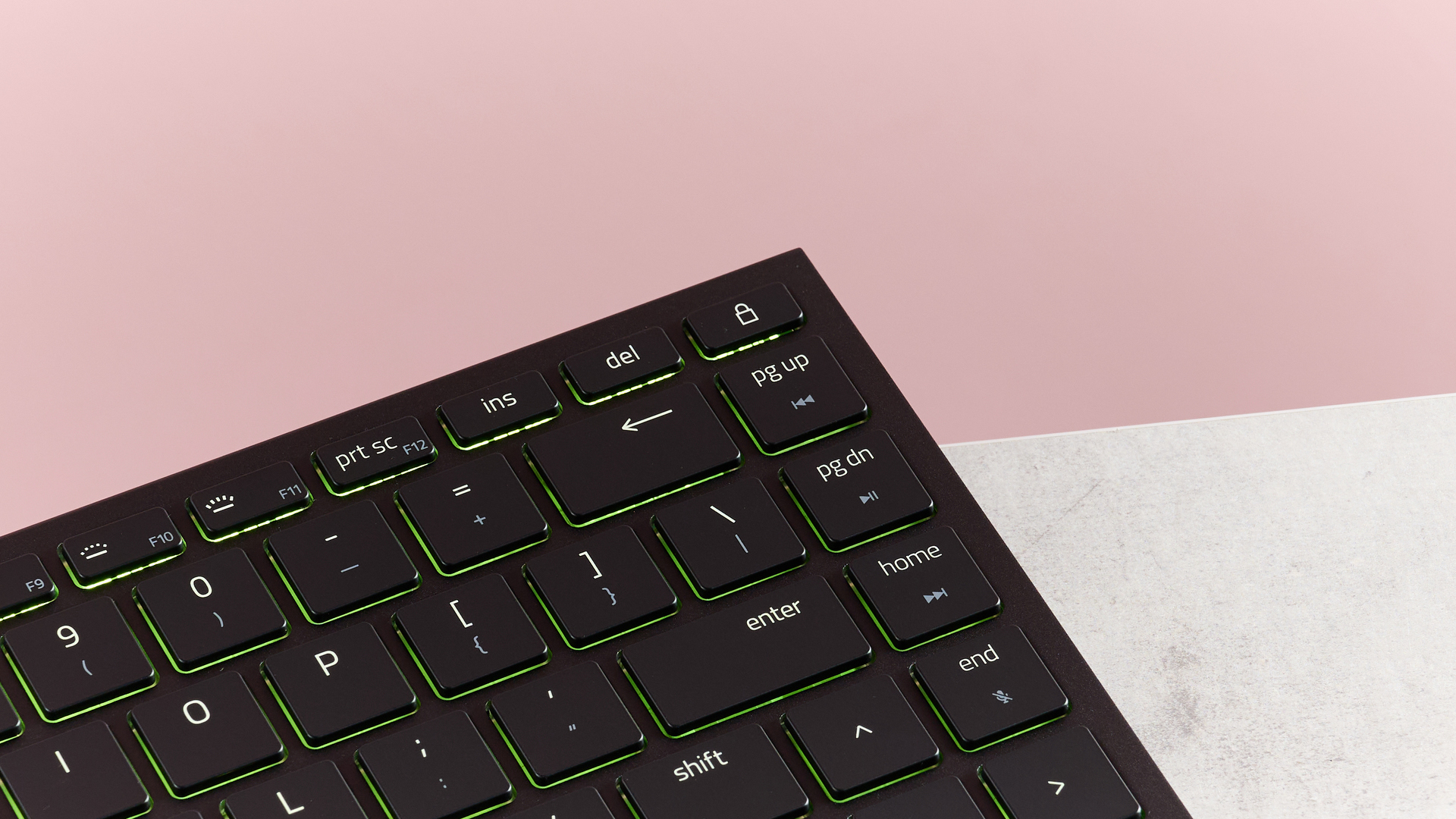
Razer Joro review: price and availability
- $139.99 / £129.99 / AU$249.95
- Available now in black only
- Expensive for what you get
The Joro costs $139.99 / £129.99 / AU$249.95 and is available now in one color: black. It comes with a braided USB cable.
This is an expensive gaming keyboard, dearer than some larger models with more features and better performance, such as the MonsGeek FUN60 Ultra, which has analog switches and provides plenty of adjustability. The board itself is quite heavy, so it’s not exactly portable, but it does show just how much keyboard you can get for a cheaper price than the Joro.
If you want a more premium experience in a similarly small package to the Joro, the Apex Pro Mini is a great alternative. It has an even more upmarket design, and boasts incredible performance thanks to its analog keys, which also offer a wealth of customization options. All of this makes it a strong contender for the best keyboard of its kind.
Value: 2.5 / 5
Razer Joro review: specs
Layout | Compact 75% |
Switch | Razer Ultra Low-Profile Switches |
Programmable keys | Yes |
Dimensions | 11.7 in x 4.4 in x 0.65in / 298 x 112 x 16.5mm |
RGB or backlighting | Yes (customizable) |
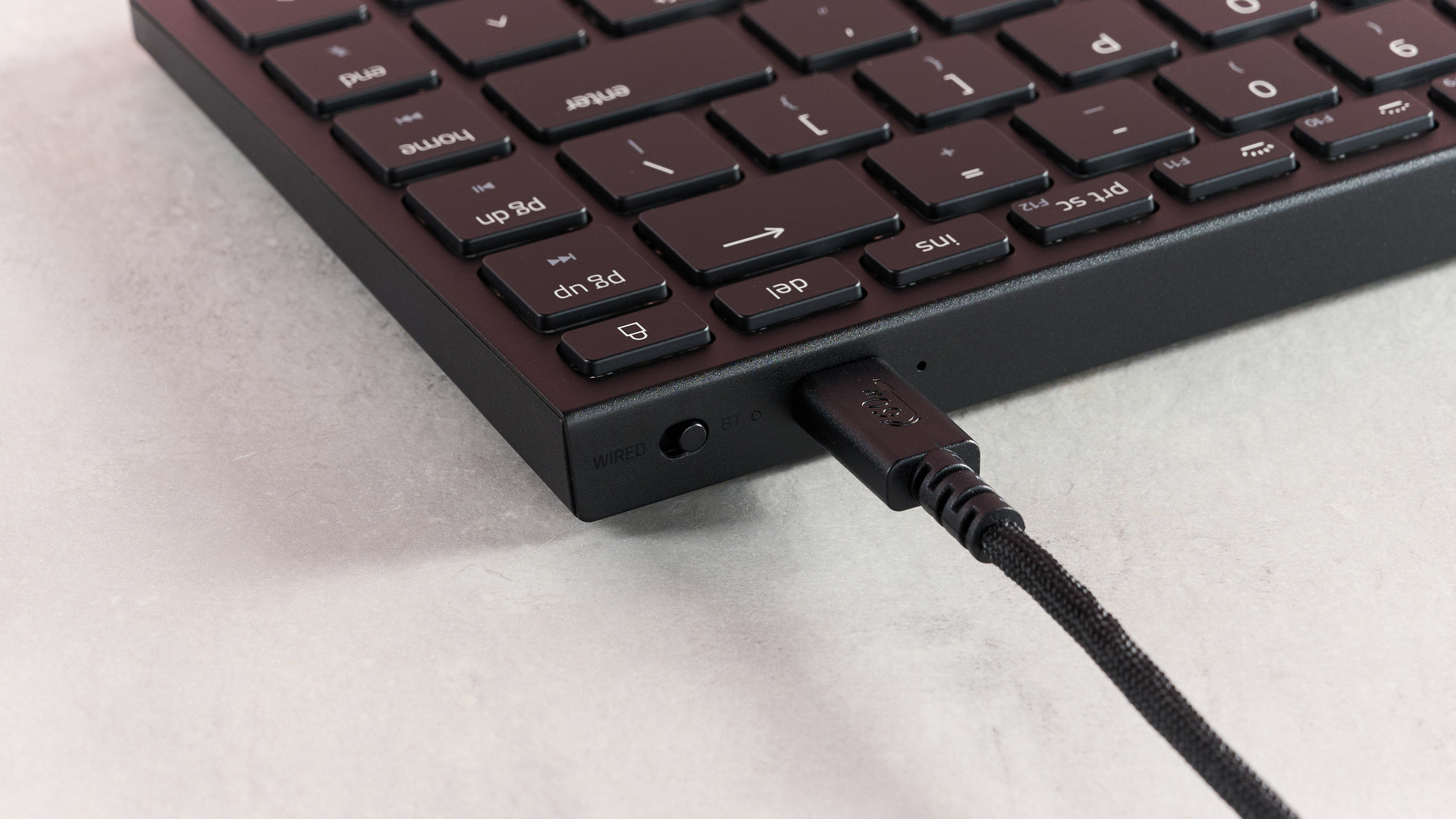
Razer Joro review: design and features
- Well-made
- Small form factor
- Lacks adjustable feet
The Joro has a functional form that eschews many of the ostentatious stylings of your typical gaming keyboard, opting for a more mature and functional approach. It’s all the better for it in my view, as it cuts quite a smart and elegant figure.
As you would expect from a keyboard designed for portability, it’s small across all its dimensions and light in weight. However, it still feels solid and well-made, helped in part by the aluminum top plate, falling in line with Razer’s high build-quality standards.
This extends to the keycaps, which feel soft and premium to the touch. Despite its small size, there are a surprising number of keys included as well, such as arrow keys, navigation keys, and an F row. What’s more, there are some handy Fn shortcuts, all labelled on the keys themselves, as well as three Bluetooth hot-switches on keys F1-F3 that are very convenient.
The sloping chassis provides a minimal tilt angle, and since there are no folding feet, this can’t be adjusted according to preference, which is a shame and limits its ergonomics, at least for some gamers.
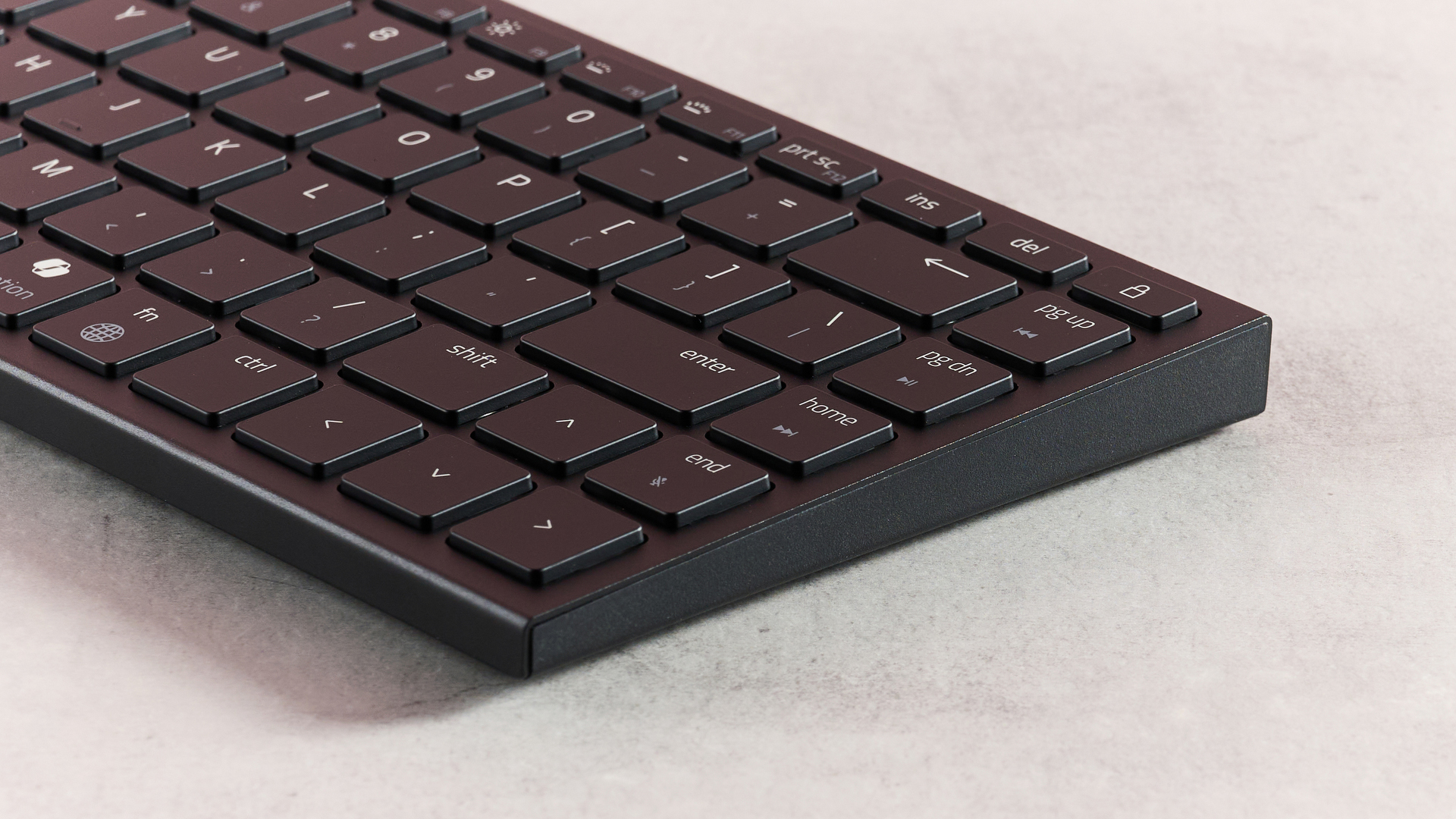
Packaged with the Joro is a braided USB cable that again feels premium. It’s quite short, which makes sense for a portable keyboard as you’ll likely be close to whatever device you’re gaming on, but desktop users might struggle to use it with their setup. What’s more, it’s USB-C-to-C, with no USB-A adapter included, which also limits its usage.
The keyboard can be customized using Razer Synapse, which features all the usual gaming peripheral customizations, including RGB tweaks and macro creation. There are also plenty of remapping options, with copious amounts of media and system shortcuts to assign. There aren’t too many performance based tweaks, although there is a Snap Tap feature, which lets you give priority to one of a pair of keys (of your choosing) when both are pressed at the same time.
Design & features: 4 / 5
Razer Joro review: performance
- Adequate gaming performance
- Better for typing
- Disappointing battery life
Despite its small and portable nature, the Joro still prioritizes gaming performance, with properties such as N-Key Rollover and Anti-Ghosting testifying to that fact.
However, in action I found the keys a little too slow for fast WASD movements, lacking the snappiness I usually prefer. Also, this position can feel a little cramped: although the keys seem generously spaced horizontally, they feel compromised vertically, which can result in discomfort after long sessions.
I found typing with the Joro better, with the aforementioned spacing helping with accuracy and ease of use. I also preferred their low profile, emulating laptop keys.
However, the keys lack dampening, which makes them feel a little harsh when hammering away at them. They certainly don’t provide as much feedback or satisfaction as the best mechanical keyboards in this department.
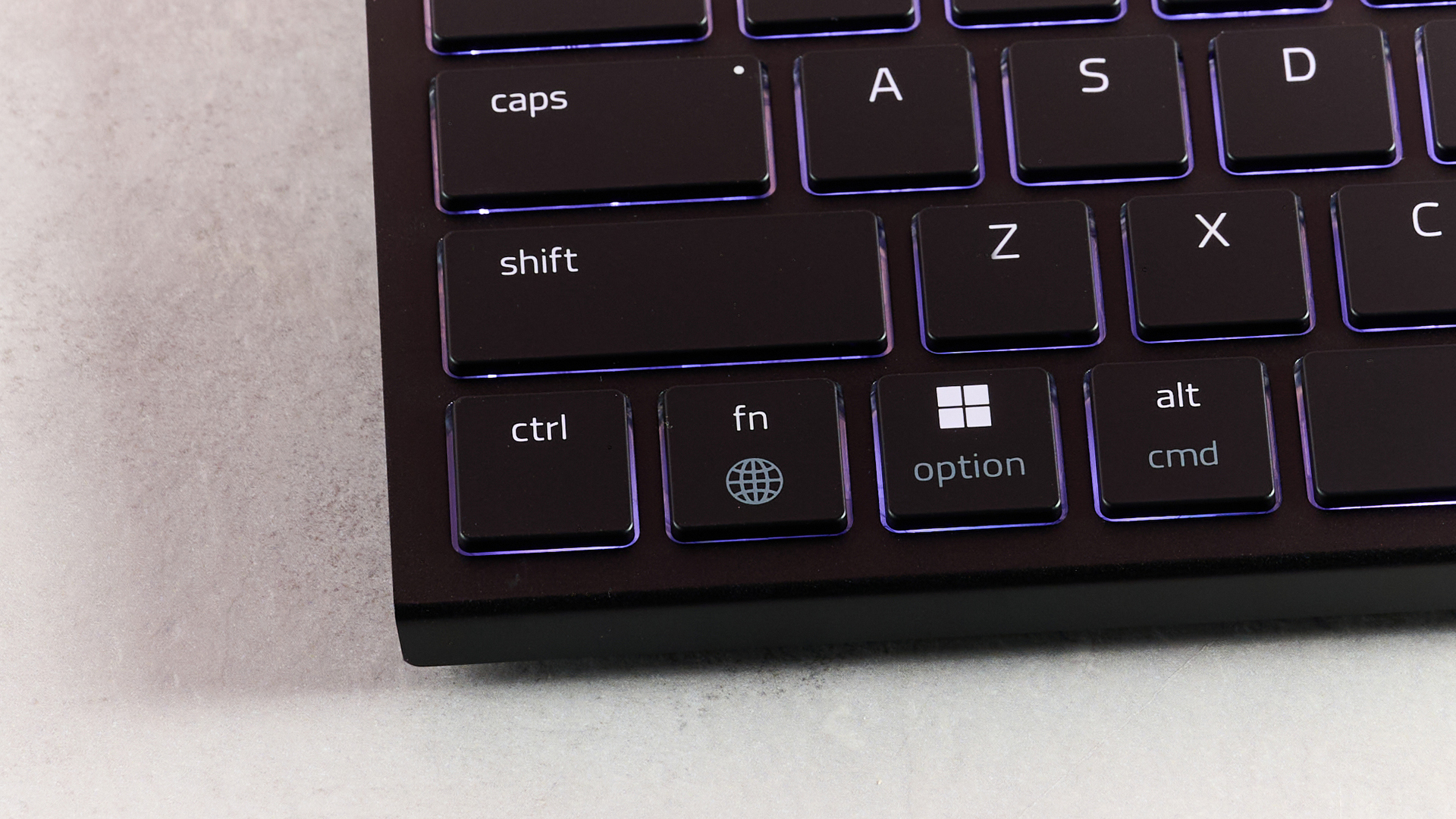
What’s more, the small layout did give me some issues when using the Joro for productivity. For instance, the right Shift key is very small, so I often hit the keys above when reaching for it. The enter key is similarly truncated, which also took some getting used to. I was at least glad to see the arrow keys are full-sized, though.
After long sessions, I lamented the lack of adjustable feet as well, since the near-flat layout created a somewhat uncomfortable angle for my hands to reach down to.
The Bluetooth connectivity works well, and I didn’t experience any lagging issues or stuttering. Switching between multiple devices is quick and easy too, thanks to the shortcut keys.
After several days of use, and with the backlighting on, the battery dropped to from full to 4%, which isn’t a great performance, and is an especial shame for a keyboard purpose built for portability. Thankfully, the wired connection lets you use and charge the Joro at the same time.
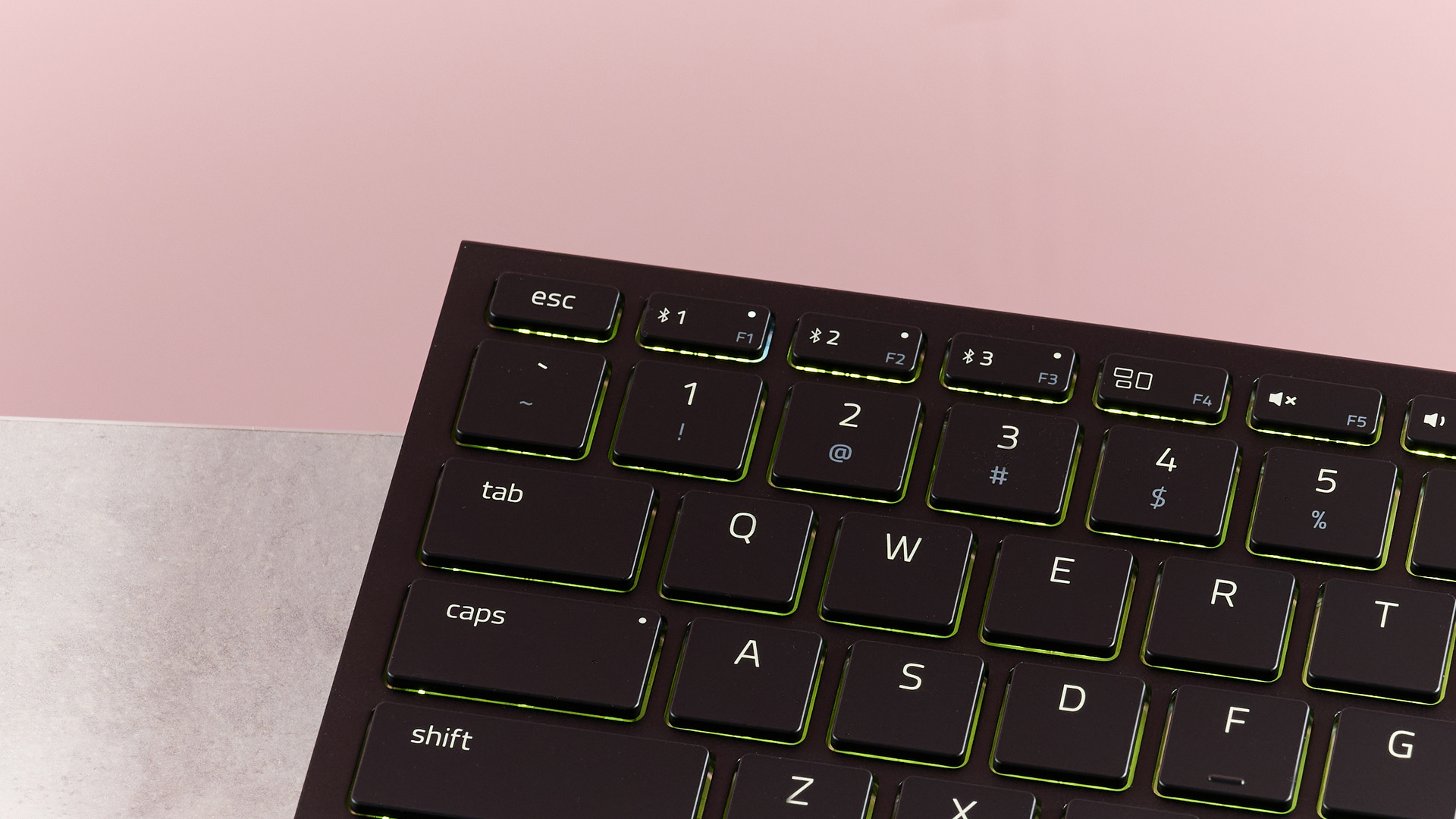
Performance: 3.5 / 5
Should I buy the Razer Joro?
Attributes | Notes | Rating |
|---|---|---|
Value | The Joro is an expensive board, and its limited performance and features struggle to justify its cost. | 2.5 / 5 |
Design and features | The Joro is well made and has some useful shortcut keys and customizations available. The lack of a 2.4GHz connection is a shame, though. | 4 / 5 |
Performance | The Joro doesn’t feel particularly great in action, and the lack of adjustable feet can make it less than ideal from an ergonomic perspective. | 3.5 / 5 |
Overall | The Joro is a reasonably competent gaming keyboard with a good design, but ultimately it's priced beyond its means. | 3 / 5 |
Buy it if…
You want to game on the go
The Joro is genuinely small and light enough to make it easy to travel with.
You want great build quality
True to many of Razer’s peripherals, the Joro looks premium and feels durable.
Don’t buy it if…
You want the best performance
If you’re after the utmost snappiness and satisfaction, you better look elsewhere.
You want to save money
The Joro is expensive for a keyboard, period – let alone one that lacks 2.4GHz connectivity and high-performing switches.
Razer Joro review: also consider
| Header Cell - Column 0 | Razer Joro | SteelSeries Apex Pro Mini Gen 3 | MonsGeek FUN60 Ultra |
|---|---|---|---|
Layout | Compact 75% | 60% | 60% |
Switch | Razer Ultra Low-Profile Switches | Analog (Hall-effect magnetic) | Analog (TMR magnetic) |
Programmable keys | Yes | Yes | Yes |
Dimensions | 11.7 in x 4.4 in x 0.65in / 298 x 112 x 16.5mm | 11.5 x 4 x 1.6 inches / 293 x 103 x 40mm | 14.7 x 7.4 x 3.1 inches / 372.9 x 187 x 79mm |
RGB or backlighting | Yes (customizable) | Yes (customizable) | Yes (customizable) |
SteelSeries Apex Pro Mini
For a seriously premium gaming experience in a small package, look no further than the Apex Pro Mini. It’s built just as well as the Joro, if not better, while the analog switches are a dream to use for gaming and typing, with plenty of actuation adjustments. It’s more expensive than the Joro, but considering what’s on offer here – which includes both Bluetooth and 2.4GHz connectivity options – it’s better value. Read our full SteelSeries Apex Pro Mini Gen 3 review.
MonsGeek FUN60 Ultra
The FUN60 Ultra shows just what you can get for a relatively small outlay into today’s keyboard market. Featuring top-draw TMR analog switches and a durable design with premium materials and features, the FUN60 Ultra is great for both gaming and typing. It also supports both 2.4GHz and Bluetooth connectivity – and, what’s more, it’s cheaper than the Joro. Read our full MonsGeek FUN60 Ultra review.
How I tested the Razer Joro
- Tested for several days
- Used for gaming, working, and browsing
- Plentiful gaming keyboard experience
I tested the Joro for several days, during which time I used it for gaming, working, and general browsing.
I played games such as Counter-Strike 2 and Atomfall, the former of which is good for testing accuracy and responsiveness, while the latter uses a wider selection of keys, which helps to assess the ease of navigation around the board.
I’ve been PC gaming for over a decade, during which time I’ve experienced a number of keyboards. I’ve also reviewed plenty of them, ranging in their size, feature-sets, and price points.
- First reviewed: June 2025
- Read more about how we test

Lewis Maddison is a Reviews Writer for TechRadar. He previously worked as a Staff Writer for our business section, TechRadar Pro, where he gained experience with productivity-enhancing hardware, ranging from keyboards to standing desks. His area of expertise lies in computer peripherals and audio hardware, having spent over a decade exploring the murky depths of both PC building and music production. He also revels in picking up on the finest details and niggles that ultimately make a big difference to the user experience.
You must confirm your public display name before commenting
Please logout and then login again, you will then be prompted to enter your display name.
